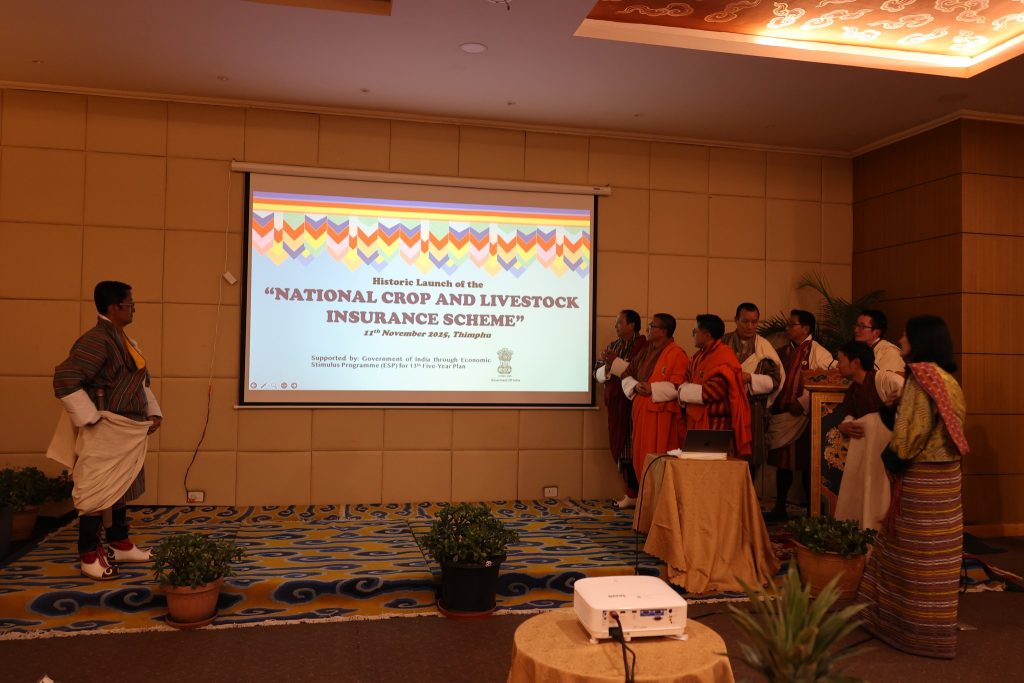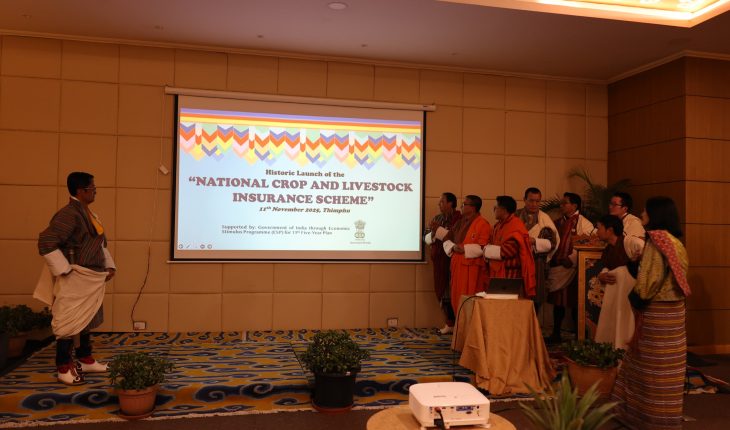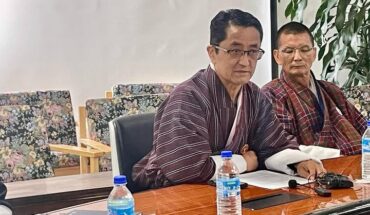
KINZANG DORJI TSHERING | Thimphu
The Ministry of Agriculture & Livestock (MoAL) has formally launched the National Crop and Livestock Insurance Scheme (NCLIS), a nationwide initiative designed to protect Bhutanese farmers from financial losses caused by climate hazards, wildlife incursions, pests, and livestock diseases. The programme was inaugurated on 11 November 2025, coinciding with the 70th birth anniversary of His Majesty the Fourth Druk Gyalpo.
Approved by the Lhengye Zhungtshog in April 2025, the scheme is implemented through a public–private partnership involving the government, the Royal Insurance Corporation of Bhutan Limited (RICBL), and Bhutan Insurance Limited (BIL). Financing comes from a Nu 800 million fund under the Economic Stimulus Programme (ESP), demonstrating the government’s commitment to strengthen the financial resilience of rural farmers.
According to the Ministry of Agriculture and Livestock (MoAL), NCLIS aims to provide farmers with a financial safety net while encouraging greater investment in agriculture. The programme covers rice, maize, potato, and mandarin, alongside livestock categories including cattle, piggery, and poultry. Premium costs are shared equally between the government and the farmers.
Speaking at the launch, MoAL Secretary Thinley Namgyel said, “This initiative embodies His Majesty the Fourth Druk Gyalpo’s long-standing vision for agricultural self-sufficiency. Recent heavy rainfall caused damages estimated at Nu 23 million, affecting more than 10,000 poultry, 635 households, and 395 acres of farmland. NCLIS will provide a vital safety net for our farming communities.”
The pilot phase of NCLIS has been rolled out in selected gewogs, including Ramjar Gewog in Trashiyangtse, where six farmers have enrolled, collectively insuring nine cattle and 1,800 poultry, bringing the total insured value to over Nu 618,269.
The six pilot participants from Ramjar Gewog include Sonam, a resident of Doongmean, who insured one Jersey cattle, locally called Kapchee, aged eight years, for Nu 51,450 with a premium of Nu 5,145; Tenzin Wangda, also from Doongmean, who also insured a two-year-old Jersey cattle named Tainee for Nu 51,450, with a premium of Nu 5,145 and a beneficiary share of Nu 2,573; Phub Dem, from Yangyungma, who insured a seven-year-old Jersey cattle called Tuku for Nu 51,450, with a premium of Nu 5,145 and a beneficiary share of Nu 2,573; These early participants illustrate the scheme’s potential to encourage farmers to proactively manage agricultural risks and safeguard their livelihoods.
Farmers from other dzongkhags have also expressed interest. Sonam Tobgay, a farmer from outside Ramjar Gewog, shared that he had insured his livestock for Nu 51,450 with a premium of Nu 5,145. He learned about the scheme through gewog meetings and agriculture extension officers.
“I know the basic idea — that it helps compensate farmers if our crops or animals are damaged or lost due to wildlife attacks, natural disasters, or disease outbreaks. But honestly, I’m not fully familiar with all the details, especially how the claims process works or what documents are needed,” Sonam said.
He expressed optimism about the programme’s potential to protect farmers. “In rural areas, wildlife attacks and unpredictable weather are our biggest worries. Many farmers lose half their harvest to boars or deer, and climate-related problems like heavy rain or hailstorms are increasing. If the insurance genuinely pays out during such losses, it will give farmers more confidence to continue farming instead of giving up,” he added.
On affordability, Sonam noted that premiums are generally manageable because of government subsidies, but some farmers may still find them challenging during lean seasons. He said he would personally consider registering if the claim process is simple, compensation is prompt, coverage is clear, and the premium fits within his annual farm expenses. He also suggested improvements, including more awareness campaigns, a simplified claims process, faster payouts, stronger support for human–wildlife conflict mitigation, and subsidies for low-income households.
Under NCLIS, crop premiums are set at 5.8 percent of the insured value, cattle premiums at 10 percent, and pig and poultry premiums at 6 percent. Farmers may opt to insure either 50 percent or 100 percent of the insured value depending on their resources. Enrollment is conducted at the chiwog level, with Chiwog Tshogpas responsible for registration and premium collection. Gewog Agriculture Extension officials conduct technical verification, including checks on land documents such as Lag-Thram or Land Use Certificates. Once premiums and documentation are submitted, coverage begins the following day. Crop insurance remains valid from sowing until harvest, with an additional 30-day post-harvest protection for paddy. Livestock and poultry can be insured year-round.
Farmers are required to report incidents to their Chiwog Tshogpa or Gewog Agriculture Extension office within 12 to 24 hours for crops and 6 to 12 hours for livestock. The gewog administration must inform the insurance company within the same timeframe. A joint verification team, comprising gewog agriculture extension officers, insurance company representatives, chiwog tshogpas, and forestry officials in cases of wildlife involvement, conducts damage assessment. Assessment reports and claims must be submitted to the insurer within three to five working days. Coverage includes losses due to natural disasters, landslides, pest outbreaks, diseases, forest fires (excluding deliberate burning), and wildlife attacks. Exclusions include intentional damage, gross negligence, malpractice, and pre-existing conditions in livestock.
RICBL Chief Executive Officer Karma stated, “The success of the insurance scheme depends on shared responsibility among the government, insurers, and farmers, and it must be integrated into the national budget to remain sustainable over the long term.”
The need for NCLIS is reinforced by national data on agricultural vulnerabilities. The National Impact Assessment Report on Electric Fencing 2021 reported that farmers lose between 19 and 43 percent of annual crops to wildlife. The Integrated Agriculture and Livestock Census 2022 recorded an eight percent decline in cereal production—equivalent to 6,319 metric tonnes—compared to 2021, alongside a 14 percent drop in the national cattle population. NCLIS aims to reduce these risks, strengthen food security, and provide Bhutanese farmers with reliable financial protection. Officials stressed that accurate reporting and adherence to procedures are crucial for timely and fair compensation.
With the pilot phase underway in Trashiyangtse, NCLIS marks a historic step in protecting Bhutanese farmers against climate, wildlife, and disease-related losses. As the programme expands to additional gewogs and dzongkhags, it is expected to strengthen rural livelihoods, encourage investment in agriculture, and ensure sustainable development for communities across Bhutan.





